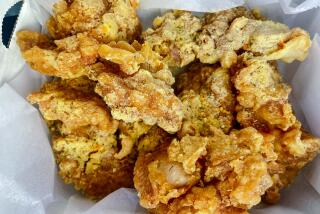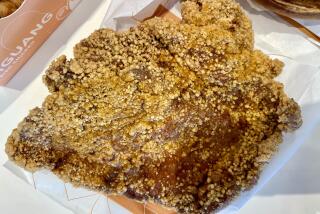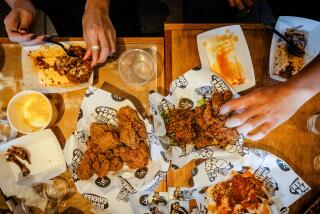Fast-Food Race in China Speeds Up : Restaurants: Foreign and local firms fight hard for a piece of the nation’s $3.5-billion market.
- Share via
BEIJING — When Kentucky Fried Chicken’s Col. Sanders faces off against Glorious China Chicken at a crowded Beijing crossroads, you know you are on the front line of China’s fast-food wars.
Foreign and local firms are fighting hard for shares in a nationwide market worth $3.5 billion last year and expected to grow at 20% annually.
On one corner of the intersection is Kentucky Fried Chicken, which opened in 1988 and now serves 3,000 customers a day, pulling in about $175,000 a month.
On two other corners, Chinese challengers offer local-style fast food at slightly lower prices.
“Our aim is for Chinese fast food to triumph over Western fast food,” said a staff member at Rong Hua Ji (Glorious China Chicken). “We opened at this site in October last year in order to compete with Kentucky.”
Rong Hua, a state-owned company based in Shanghai, has announced a policy of opening outlets close to KFC’s. It has six shops in Shanghai and one in Beijing and plans to open more in the capital.
“We welcome the competition,” said Xu Xiaoyong, manager of the KFC branch. “Only through competition comes progress. Our turnover has increased 20% since Rong Hua opened.”
KFC already has seven outlets in Beijing and also plans to open more next year.
Other U.S. firms are in the Chinese market, including McDonald’s, as well as French, British and Canadian companies.
The fast-food war was the subject of a national conference in Beijing earlier this month, at which 60 food industry experts from all over the country planned a Chinese counterattack against the Western invasion.
“We must combine cuisine and technology to speed up the development of all kinds of Chinese fast food,” said Ling Dawei, head of the food and drink service department in the Ministry of Internal Trade.
“We must develop new equipment and provide policy support. Chinese fast food must be silent no longer,” he said.
“Fast food is an international business. The world market needs Chinese fast food,” said the Commercial News, the ministry’s mouthpiece.
“There is huge potential to open the world market. This is a chance given to us by history that we must seize with both hands,” it said.
The paper said China must combine foreign management and production techniques with the traditional excellence of Chinese cuisine to create fast food that appeals to foreigners and Chinese alike.
The fast-food business is booming in China for the same reasons as elsewhere in Asia.
As the economy heats up, people eat away from home more. They have more money to spend. Some, especially the young, are keen to sample Western flavors.
“I come here once every two days,” said Wang Wei, nibbling at his KFC chicken. “I live nearby and am not married. I travel a lot on business, so this place suits me.
“We do not come here just for the food, of course. It is also a little piece of America,” he said, glancing at the Christmas tree and decorations as “Silent Night” blared over the sound system.
The two-story shop looks about like any KFC outlet elsewhere in the world.
“If a South American or East European firm sold exactly the same food, Beijing people would not come,” said Liu Hung, a student who often comes for chicken with his friends. “They would not have the same appeal. The U.S. has the charisma.”
Across the road at Rong Hua, the single-story shop is full of diners digging into their lunch of chicken, rice, vegetable and soup for $1.50.
At KFC, a two-piece chicken lunch goes for $2.20.
“The food here suits Chinese people better,” said one Rong Hua diner in his 50s. “If you want to open a fast-food restaurant, do not just import everything from the West. Change it to suit the Chinese palate and our way of managing people.”
KFC’s Xu says the fast-food market in Beijing is nowhere near saturated.
More to Read
Sign up for Essential California
The most important California stories and recommendations in your inbox every morning.
You may occasionally receive promotional content from the Los Angeles Times.













